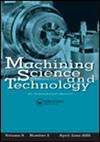In process temperature and tool wear for the machining of aeronautic aluminum under different lubrication conditions
IF 2.6
4区 工程技术
Q2 ENGINEERING, MANUFACTURING
引用次数: 0
Abstract
AbstractThe use of aluminum-lithium alloys in aeronautics is an efficient solution for lightweight structures, but its machinability can cause increased tool wear. The cutting temperature is one of the most important parameters controlling the tool wear and the quality of machined surfaces. Therefore, its measurement is of great interest to analyze the heat generation during the cut and then being able to limit it in the cutting edge. This article presents an original experimental study of the cutting temperature of two aluminum alloys (7000 series and Li-containing 2000 series), for dry, MQL: Minimum Quantity of Lubrication and wet machining conditions. The interactions between tool wear and cutting temperature are also investigated. To be able to observe tool wear, the milling of very large volumes of aluminum alloys has been necessary since the tool lifetime is several hours when machining this kind of material. To measure temperature as close as possible the cutting zone, an original set-up with machinable thermocouples was used, enabling measurements on a large frequency bandwidth. Complementary investigations by Second Ion Mass Spectroscopy revealed a diffusion of lithium in the cutting insert, which can reduce its lifetime (divided by 8, with the Li-containing 2000 series compared to the 7000 series).Keywords: Cutting temperaturelubricationmachinable thermocouplestool wear AcknowledgmentsThis study is part of the CUT project managed by IRT Jules Verne (French Institute in Research and Technology in Advanced Manufacturing Technologies for Composite, Metallic and Hybrid Structures). The authors wish to acknowledge the industrial and academic partners of this project, Constellium, Europe Technologies, Capacités, Airbus, l’Université de Nantes and Arts et Métiers. We also would like to sincerely acknowledge Kevin DAUVERGNE, from Europe Technologies, for his great help during this study.Disclosure statementNo potential conflict of interest was reported by the authors.不同润滑条件下航空铝合金加工的工艺温度和刀具磨损
摘要铝锂合金在航空领域的应用是解决轻量化结构的有效方法,但其可加工性会增加刀具的磨损。切削温度是控制刀具磨损和加工表面质量的重要参数之一。因此,它的测量是非常感兴趣的分析热产生在切割过程中,然后能够限制它在切割边缘。本文介绍了两种铝合金(7000系列和含锂2000系列)在干、最少润滑量和湿加工条件下的切削温度的原始实验研究。研究了刀具磨损与切削温度之间的相互作用。为了能够观察刀具磨损,铣削非常大量的铝合金是必要的,因为在加工这种材料时,刀具寿命是几个小时。为了测量尽可能靠近切割区域的温度,使用了可切削热电偶的原始设置,从而可以在大频率带宽上进行测量。第二离子质谱的补充研究表明,锂在切削刀片中的扩散会减少其寿命(除以8,含锂的2000系列与含锂的7000系列相比)。本研究是法国复合材料、金属和混合结构先进制造技术研究与技术研究所(IRT Jules Verne)管理的CUT项目的一部分。作者要感谢这个项目的工业和学术合作伙伴:Constellium、欧洲技术公司、capacitcims、空客、南特大学和Arts et msamiers。我们也要衷心感谢来自欧洲技术公司的Kevin DAUVERGNE,他在研究过程中给予了我们很大的帮助。披露声明作者未报告潜在的利益冲突。
本文章由计算机程序翻译,如有差异,请以英文原文为准。
求助全文
约1分钟内获得全文
求助全文
来源期刊

Machining Science and Technology
工程技术-材料科学:综合
CiteScore
5.70
自引率
3.70%
发文量
18
审稿时长
6 months
期刊介绍:
Machining Science and Technology publishes original scientific and technical papers and review articles on topics related to traditional and nontraditional machining processes performed on all materials—metals and advanced alloys, polymers, ceramics, composites, and biomaterials.
Topics covered include:
-machining performance of all materials, including lightweight materials-
coated and special cutting tools: design and machining performance evaluation-
predictive models for machining performance and optimization, including machining dynamics-
measurement and analysis of machined surfaces-
sustainable machining: dry, near-dry, or Minimum Quantity Lubrication (MQL) and cryogenic machining processes
precision and micro/nano machining-
design and implementation of in-process sensors for monitoring and control of machining performance-
surface integrity in machining processes, including detection and characterization of machining damage-
new and advanced abrasive machining processes: design and performance analysis-
cutting fluids and special coolants/lubricants-
nontraditional and hybrid machining processes, including EDM, ECM, laser and plasma-assisted machining, waterjet and abrasive waterjet machining
 求助内容:
求助内容: 应助结果提醒方式:
应助结果提醒方式:


